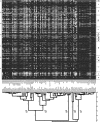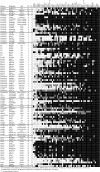Comparative genomics of host-specific virulence in Pseudomonas syringae
- PMID: 16951068
- PMCID: PMC1602070
- DOI: 10.1534/genetics.106.060996
Comparative genomics of host-specific virulence in Pseudomonas syringae
Abstract
While much study has gone into characterizing virulence factors that play a general role in disease, less work has been directed at identifying pathogen factors that act in a host-specific manner. Understanding these factors will help reveal the variety of mechanisms used by pathogens to suppress or avoid host defenses. We identified candidate Pseudomonas syringae host-specific virulence genes by searching for genes whose distribution among natural P. syringae isolates was statistically associated with hosts of isolation. We analyzed 91 strains isolated from 39 plant hosts by DNA microarray-based comparative genomic hybridization against an array containing 353 virulence-associated (VA) genes, including 53 type III secretion system effectors (T3SEs). We identified individual genes and gene profiles that were significantly associated with strains isolated from cauliflower, Chinese cabbage, soybean, rice, and tomato. We also identified specific horizontal gene acquisition events associated with host shifts by mapping the array data onto the core genome phylogeny of the species. This study provides the largest suite of candidate host-specificity factors from any pathogen, suggests that there are multiple ways in which P. syringae isolates can adapt to the same host, and provides insight into the evolutionary mechanisms underlying host adaptation.
Figures



References
-
- Abramovitch, R. B., and G. B. Martin, 2004. Strategies used by bacterial pathogens to suppress plant defenses. Curr. Opin. Plant Biol. 7: 356–364. - PubMed
-
- Alfano, J. R., and A. Collmer, 2004. Type III secretion system effector proteins: double agents in bacterial disease and plant defense. Annu. Rev. Phytopathol. 42: 385–414. - PubMed
-
- Alfano, J. R., A. O. Charkowski, W. L. Deng, J. L. Badel, T. Petnicki-Ocwieja et al., 2000. The Pseudomonas syringae Hrp pathogenicity island has a tripartite mosaic structure composed of a cluster of type III secretion genes bounded by exchangeable effector and conserved effector loci that contribute to parasitic fitness and pathogenicity in plants. Proc. Natl. Acad. Sci. USA 97: 4856–4861. - PMC - PubMed
-
- Badel, J. L., A. O. Charkowski, W. L. Deng and A. Collmer, 2002. A gene in the Pseudomonas syringae pv.tomato Hrp pathogenicity island conserved effector locus, hopPtoA1, contributes to efficient formation of bacterial colonies in planta and is duplicated elsewhere in the genome. Mol. Plant Microbe Interact. 15: 1014–1024. - PubMed
Publication types
MeSH terms
Substances
LinkOut - more resources
Full Text Sources

